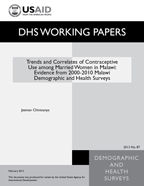
Abstract:
This study investigates levels and trends in
modern contraceptive use among married women
in Malawi and explores differences by socio-
demographic characteristics. The study uses
panel data from the 2000, 2004, and 2010
Malawi Demographic Health Surveys (MDHS),
employing multinomial logistic regression.
Background variables include the
characteristics of women, such as education,
urban-rural residence, age, marital status,
household wealth, and access to media. In
addition, the study explores differences by
fertility indicators, including number of
children born, desire for more children, and
ideal family size.
Modern contraceptive use among married women
in Malawi changed little between 2000 and
2004 but increased considerably between 2004
and 2010, from 26% to 42%. Modern
contraceptive use remains higher among
married women with more education, women in
wealthier households, and women with more
access to media, although women in most
categories have shown increases in
contraceptive use. For example, modern
contraceptive use
among women in rural areas increased from 27%
in 2004 to 39%in 2009, compared with an
increase among urban women from 35% to 46%
over the same period.
The study found that number of living
children was significantly associated with
modern contraceptive use in all three
surveys. Also, women who reported that they
wanted to have another child and those who
were uncertain about childbearing were
significantly more likely to use modern
contraception in 2004 and 2010 compared with
2000. Among women who wanted no more
children, contraceptive use increased
significantly in 2010 compared with 2000.
Increased contraceptive use among women who
want no more children and women with high
parity indicate that a growing percentage of
women want to limit and space childbearing.
Thus making effective and long-acting
contraceptive methods more available would
help many women attain their desired
fertility goals. At the same time, the strong
association between women’s education and
modern contraceptive use identified in the
study suggests that considerable progress has
been achieved in women’s education in Malawi,
which may have contributed to increases in
contraceptive use.
 Trends and Correlates of Contraceptive Use among Married Women in Malawi: Evidence from 2000-2010 Malawi Demographic and Health Surveys (PDF, 503K)
Trends and Correlates of Contraceptive Use among Married Women in Malawi: Evidence from 2000-2010 Malawi Demographic and Health Surveys (PDF, 503K)
